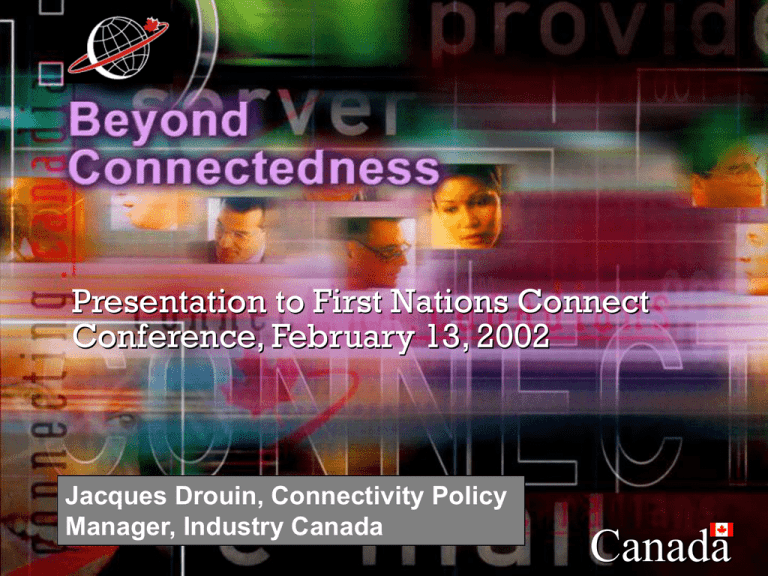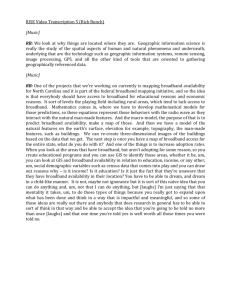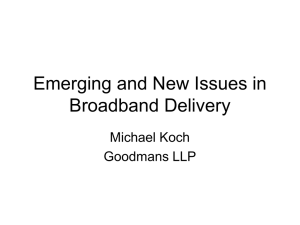webcopy-session8-jacques - Smart First Nations Project
advertisement

Presentation to First Nations Connect Conference, February 13, 2002 Jacques Drouin, Connectivity Policy Manager, Industry Canada Canada Connecting Canadians National Vision "Make the information and knowledge infrastructure accessible to all Canadians, thereby making Canada the most connected nation in the world." Speech from the Throne, 1997 2 We Are Now in the Network Age "Today's technological transformations are intertwined with another transformation globalization - and together they are creating a new paradigm: the network age.” United Nations Human Development Report, July 2001 Instant access to knowledge Transforming business Borderless, global economies New ways of citizen - government engagement 3 A Six Part Agenda Established Canada Online Smart Communities Canadian Content Online Electronic Commerce Canadian Governments Online, and Connecting Canada to the World 4 Canada Online: Ensuring Access for All Canadians www.connect.gc.ca First country in the world to connect all schools & libraries Over 300,000 computers delivered to schools 8,800 Community Access Sites 11,000 voluntary organizations connected Education & Skills For Jobs and Growth Employment Growth by Highest Level of Education Attained 1990-2000 Change 1990-00 (000s) Level 2000 (000s) +2,455 7,777 +363 4,616 -993 2,517 Post -secondary Diploma or Degree 140 120 High School Diploma 100 Less than High School 80 60 90 91 92 93 94 95 96 97 98 99 00 Index (1990=100) Digital literacy critical in the Network Age 6 Digital Divide Still Exists Internet Use from Any Location By Education By Income Percent of households, 2000 Percent of households, 2000 79 78 61 55 43 24 22 Less than High School or High School College University Degree <$20,000 $20,001 $35,999 $36,000 $59,999 >$60,000 Must increase efforts to ensure that no Canadians are left behind Source: Household Internet Use Survey; Statistics Canada, 2001 7 Smart Communities http://smartcommunities.ic.gc.ca $60M Government Commitment Yellowknife Northern Saskatchewan Calgary Coquitlam + Brandon + Labrador Péninsule Acadienne + Shawinigan + Charlottetown + Sioux Lookout Ottawa Annapolis + …New Model for Community Development 8 Canadian Content Online http://collections.ic.gc.ca $108M to bring Canadian culture into the Digital Age 9 Electronic Commerce www.e-com.ic.gc.ca PKI Consumer Protection Privacy Digital Signatures Intellectual Property Security / Encryption Standards Tax Neutrality E-Commerce in Canada $ Billions 250 200 B2B 150 100 50 B2C 0 1999 2000 2001 2002 2003 2004 2005 Source: Internet Commerce in Canada, IDC 2001 “The real story is about the e-transformation of traditional businesses” The OECD Observer, September 25, 2001 10 Canadian Governments Online www.canada.gc.ca "By 2004, our goal is to be known around the world as the government most connected to its citizens." Overall Maturity* Speech From the Throne, 1999 50% 2001 2000 40% 30% 20% 10% 0% Canada Singapore United States Norw ay Australia Client-centric – Integrated – Interactive – E-Com enabled Source: Accenture, April 2001 11 Canadians Are Receptive to Government Online Services Tax returns filed electronically in Canada Millions Percent 6 5.5 4.9 5 4 3.2 3 23.4 6.0 30 5.1 4.5 3.9 5.8 24.1 25.5 26.4 27.3 25 20 21.8 19.4 15 15.8 2 10 1 5 0 0 1993 1994 1995 1996 Number of Returns E-Filed (Left Axis) 1997 1998 1999 2000 % of Total Tax Returns Filed (Right Axis) Source: Canada Customs and Revenue Agency; October 2001. 12 Basic Connectivity No Longer Sufficient Tele-working Videoconferencing Tele or E-Learning Tele-medicine Video Telephony Near VoD Movies-on-demand Audio-on-demand 1.5 Mbps Telegames Home Shopping Electronic Banking Elect. Newspaper Digital TV 10 100 1000 10000 Kilobits/second Source: PlannedapproachInc.com 13 Broadband IS the Platform Inclusive Society Innovative Economy Skilled & Empowered Citizens Increased Competitiveness Knowledge Networks Broadband 14 What Can Broadband Deliver? Increasing volumes of content and services Virtual face-to-face interaction Substantially improved existing services and creation of innovative and bandwidth-intensive ones: E-Learning - learning anywhere, anytime Tele-health -saving lives and money through networking E-com - supporting new ways of doing business E-research - exponential improvements in research capacity E-government - fully engaging all citizens Allows ALL Canadians, wherever they are, to participate in the Innovation Agenda 15 U.S. Economic Study Agrees The $500 Billion Opportunity: The Potential Economic Benefit of Widespread Diffusion of Broadband Internet Access Crandall and Jackson, July 2001 An attempt to look at what life could be like with ubiquitous broadband access Study identified five sources of benefit: Telecommuting Entertainment Telemedicine Telephony Home On-line shopping Widespread use of broadband could contribute between $200B and $500B annually to U.S. economy by 2025 16 Global Race to Get Competitive Advantage Through Broadband Sweden C$1.24B Goal: Universal broadband access by 2005 Focus on underserved locations & groups (30% pop.) $765M for transport; $480M for municipal nets and tax relief U.S. C$3.35B/year Goal: extend universal service to include advanced services. Multiple federal, state and local programs: e.g., $3.2B/year for statutory E-rate program, 153M/year for Rural Broadband Loan Program pilot project. Nearly 40 bills before Congress to accelerate broadband in rural and underserved areas. France C$2.2B Goal: Universal broadband access by 2005 Focus on underserved, rural locations (20 to 25% of pop.) $300M direct for infrastructure & deployment; $1.9B in government funded loans for infrastructure deployment. U.K. Not yet funded Universal broadband access by 2005 Program announcement anticipated 17 Global Race to Get Competitive Advantage Through Broadband Germany C$1.1B JAPAN yet funded Korea C$25B (1997-2002) Goal: Leadership in EU Information Society Broadband from ADSL to 8 Mbps Target 2006 Not Goal: World IT leadership by 2005. “Ultra high speed” goal of 30 Mbps to 30 million homes. $41M seed funding sought 2002; full funding announcement expected shortly. Goal: World IT leadership Broadband by 2002; Total Korea Information Infrastructure investment $47B to 2005. “The information society is and will remain a top priority for the EU. It can foster economic growth, provide jobs, connect remote places to urban centres and raise living standards. This has not changed.” EC Commissioner, Erkki Liikanen, Sept 28, 2001 18 Canada Well Positioned High-speed Internet Users per 100 inhabitants South Korea Canada Sweden United States Netherlands Austria Belgium Denmark Germany Japan Switzerland Iceland 0 Source: OECD, 2001 2 4 6 8 10 12 14 16 19 But Canada Faces Unique Geographic Challenges Population Densities OECD Nations Relative to other countries Canada has low population density Rural/remote areas Netherlands Japan United Kingdom Germany unlikely to be served by market forces, as business case nonexistent Italy Switzerland Denmark France Ireland United States Rural, remote and north at risk! Sweden Canada Australia 0 200 400 600 800 1000 1200 Population per square mile SOURCE: U.S. Department of Commerce, Bureau of the Census, Statistical Abstract of the United States, 1992, Tables 25, 340 and 1359 20 Majority of Canadian communities do not have access to high-speed service Canadian Communities* 5,984 4,781 Communities 22.3 % of pop. Both DSL and Cable 5% No High Speed Service 79% Only DSL 10% 1,203 communities 77.7 % of pop. Only Cable 6% *Communities refer to Statistics Canada Census Sub-division (CSD) breakdown. Source: Industry Canada estimates based on 1996 population data from STC and confidential company information. 21 Smaller Communities Most at Risk % of Community Size Group 100% 92% Unserved Communities By Size (4781 Communities*) 90% 79% 76% 80% 70% 60% 50% 50% 40% 30% 22% 20% 10% 0% 0% # of communities % of population 0-1,000 1,000-5,000 3 230 4.0% 1 309 9.4% 5,000-10,000 10,000-100,000 100,000 + 163 3.9% 79 5.0% 0 0 Canada 4 781 22.3% * Communities refer to Statistics Canada Census Sub-divisions (CSDs) Source: Industry Canada estimates based on 1996 population data from STC and confidential company information. 22 Access to High-Speed Service Varies by Province 100% Access to High-Speed Service 1,203 Communities* % of Provincial Communities 90% 80% 70% 60% 50% 44% 40% 30% 43% 29% 28% 23% 21% 24% 20% 8% 10% 7% 20% 12%14% 5% 0% NF PEI NS NB QC ON MB SK AB BC NWT *:Communities refer to Statistics Canada Census Sub-division (CSD) breakdown. Source: Industry Canada estimates based on 1996 population data from STC and confidential company information. NU YT CDA Should Rural Canada Have the Same Opportunities as Urban Canada? Economic viability and sustainability in question for many rural and remote communities Businesses leave Jobs leave Youth leave Needs are greatest where services less available or not available “Without innovative public policy, these technologies could become a source of exclusion, not a tool of progress.” United Nations Development Report, July 2001 24 Government is Committed to Equal Access for ALL Canadians Established National Broadband Task Force Mandate: the need and characteristics of communities not likely to gain access to high-speed services by 2004 the technical, institutional and financial barriers which could delay provision of services by the private sector the roles governments might play in overcoming these barriers Membership: Leading Canadians from all sectors: Industry (telcos, cablecos, service providers, content providers) Public interest Education and libraries Health Aboriginal 25 National Broadband Task Force’s Response www.broadband.gc.ca Essential that ALL Canadians have access Make it equitable and affordable Ensure balanced public-private partnership Understand it is more than infrastructure that is required (encourage use and content development) Place highest priority on First Nations, rural and remote Called for total investment of $4.6B by ALL PARTNERS (federal, provincial, territorial, municipal governments, and private sector) Community Champion seed funding to all unserved communities ($50 to $70M) Transport to unserved communities ($1.3B to $1.9B) Connect public institutions in unserved communities ($500M to $600M) “Last mile” to homes within unserved communities ($2B) 26 Wide Partnership Required e-health e-content e-learning Broadband Platform e-government e-business 27 Budget 2001 Continuing Support for Connectedness Agenda SchoolNet and CAP - $40M per year for two years $35M/year for the three years to support broadband expansion $110M to build CA*net 4 – the next generation Internet broadband backbone $600M over next four years to implement GOL strategy by 2005 Commitment to vision of broadband connectivity to all communities – timeline extended to 2005 … The Challenge Continues 28 Connecting Canadians Canada’s Innovation Strategy White Paper What does innovation mean? It means: - Coming up with new ideas about how to do things better or faster - Making a new product or offering a new service - Putting new ideas to work…and having skilled people to apply them - Agressively pursuing new markets for Canada ’s products and services Canada Connecting Canadians Canada’s Innovation Strategy White Paper Communities seen as incubators of innovation But tey have to be part of the globally connected world Broadband connectivity is an enabler of innovation Government will work together to strenghten the capacity of communities to become incubators of innovations Goal: by 2005, ensure that broadband is available to Canadian communities Canada Connecting Canadians For Further Information Industry Canada www.ic.gc.ca Connecting Canadians www.connect.gc.ca Strategis www.strategis.gc.ca Electronic Commerce www.e-com.ic.gc.ca National Broadband Task Force www.broadband.gc.ca Canada



